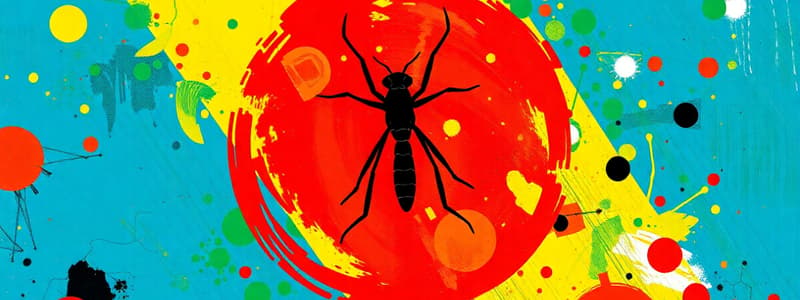Podcast
Questions and Answers
What was DDT primarily used for when it was first produced?
What was DDT primarily used for when it was first produced?
- To kill insects (correct)
- To serve as an animal repellent
- To fertilize crops
- To promote plant growth
DDT breaks down in the environment quickly.
DDT breaks down in the environment quickly.
False (B)
What harmful effect does DDT have on birds' eggs?
What harmful effect does DDT have on birds' eggs?
It makes the shells very thin and easy to break.
DDT was first produced in the ______.
DDT was first produced in the ______.
Match the following effects of DDT with their descriptions:
Match the following effects of DDT with their descriptions:
Who wrote the book Silent Spring?
Who wrote the book Silent Spring?
DDT is beneficial for ecosystems.
DDT is beneficial for ecosystems.
What animals were primarily affected by DDT according to the content?
What animals were primarily affected by DDT according to the content?
What is the main activity conducted in the experiment?
What is the main activity conducted in the experiment?
In the experiment, each small bird can feed on multiple insects at the same time.
In the experiment, each small bird can feed on multiple insects at the same time.
What happens to the quantity of DDT in an animal's body as you go up the food chain?
What happens to the quantity of DDT in an animal's body as you go up the food chain?
In the food chain, algae serve as the ______ for shrimps.
In the food chain, algae serve as the ______ for shrimps.
Match the following organisms with their position in the food chain:
Match the following organisms with their position in the food chain:
What is a potential outcome of bioaccumulation in a food chain involving DDT?
What is a potential outcome of bioaccumulation in a food chain involving DDT?
Explain why the mean number of red tokens that each animal has increases as you go along the food chain.
Explain why the mean number of red tokens that each animal has increases as you go along the food chain.
The experiment accurately models what happens to DDT in a real ecosystem.
The experiment accurately models what happens to DDT in a real ecosystem.
Flashcards
Mean number of red tokens (insects)
Mean number of red tokens (insects)
The average number of red tokens collected by all the 'insects' in the experiment.
Mean number of red tokens (small birds)
Mean number of red tokens (small birds)
The average number of red tokens collected by all the 'small birds' in the experiment.
Red tokens collected (eagle)
Red tokens collected (eagle)
The total number of red tokens collected by the 'eagle' in the experiment.
Biomagnification
Biomagnification
Signup and view all the flashcards
Bioaccumulation
Bioaccumulation
Signup and view all the flashcards
Why does DDT concentration increase in a food chain?
Why does DDT concentration increase in a food chain?
Signup and view all the flashcards
Model of an ecosystem
Model of an ecosystem
Signup and view all the flashcards
Food chain
Food chain
Signup and view all the flashcards
What is DDT?
What is DDT?
Signup and view all the flashcards
Why was DDT used?
Why was DDT used?
Signup and view all the flashcards
What makes DDT problematic for the environment?
What makes DDT problematic for the environment?
Signup and view all the flashcards
How does DDT affect animals?
How does DDT affect animals?
Signup and view all the flashcards
What was Silent Spring about?
What was Silent Spring about?
Signup and view all the flashcards
What type of chemical is DDT?
What type of chemical is DDT?
Signup and view all the flashcards
What is a food chain?
What is a food chain?
Signup and view all the flashcards
What is biomagnification?
What is biomagnification?
Signup and view all the flashcards
Study Notes
DDT: An Insecticide
- DDT is a chemical insecticide, used to kill insects that transmit diseases (like malaria and typhus) and crop pests
- Initially, DDT was not considered harmful to other organisms besides insects
- Later, studies revealed its harmful impact on animals, particularly birds, demonstrated in Rachel Carson’s "Silent Spring" (1962)
DDT's Persistence
- DDT is a persistent chemical that does not break down easily
- It remains in the environment for many years
- DDT can be transported long distances by wind after spraying
DDT in Food Chains
- DDT enters the food chain when sprayed or carried through the atmosphere
- DDT accumulates in organisms' bodies, stays there and does not decompose
- DDT is toxic to many animals.
- It makes bird eggshells very thin and fragile, causing the eggs to break easily, for example in ibis
- DDT is dangerous to other animals beyond birds
Bioaccumulation and Biomagnification
- Bioaccumulation: The buildup of DDT in an organism over its lifetime.
- Biomagnification: The increasing concentration of DDT at higher trophic levels of a food chain.
Studying That Suits You
Use AI to generate personalized quizzes and flashcards to suit your learning preferences.
Description
This quiz explores the effects of DDT as an insecticide, its persistence in the environment, and its impact on food chains. Learn about the bioaccumulation and biomagnification of DDT, as well as the specific damages it causes to wildlife, particularly birds. Understand the historical context and scientific studies that reveal its dangers.




